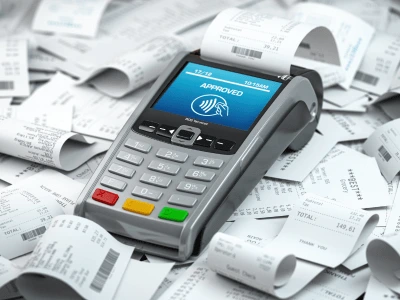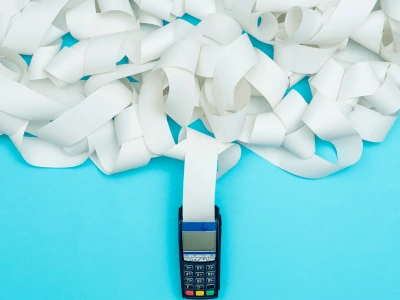
Read everything you need to know about tax receipts including what they are and how they’re used in business.

About Shoeboxed Shoeboxed is an expense & receipt tracking app that helps you get reimbursed quickly, maximize tax deductions, and reduce the hassle of doing accounting. Get Started Today
A receipt isn’t only proof of the purchase but is also a way to help calculate tax deductions, making them an important part of tax reporting.
For more information on tax and business receipts, keep reading!
Table of Contents

Receipt printer printing many receipts
You might be wondering what the difference is between a regular receipt and a tax receipt, or gross receipt.
The word “tax” can make tax receipts seem intimidating, but they’re just receipts that need to be kept for completing your taxes every year.
A tax receipt is official proof of expenses claimed on state and federal income tax returns.
An expense cannot be listed, especially for the purposes of making a tax deduction, unless there is proof to back up the claim. This is also true during a tax audit.
Without the appropriate proof, you could end up in some hot water with the IRS.
Though they help during an audit, tax receipts are also useful in calculating the precise amount of state and federal taxes owed by the business.
Some tax receipts include other income sources without any deductions, like tax refunds, donations, and dividend income.
There are state and regional tax jurisdictions that levy taxes on business tax receipts instead of corporate income taxes or sales tax.
Try Shoeboxed’s systematic approach to receipt tracking for tax season. Try free for 30 days!
For the most part, businesses will have more opportunities for tax deductions than individuals, including office rent, payroll, supplies, travel, and other relevant business categories.
The IRS considers a business tax receipt to be any documentation that shows proof of the expense.
This means that a business needs to hold on to any receipts it plans to show as proof of purchase when considering deductions from state and federal income tax returns.
Some business tax receipts include anything that is not strictly related to business activity, such as donations, tax refunds, interest, and dividend income.
In some areas of the United States, a business tax receipt is actually a document provided by a local municipality that shows the business made all necessary tax payments and is allowed to operate within the region.

Making a donation to receive a donation tax receipt
Within the United States, tax-exempt organizations, such as those holding a 503(c)(3) classification, can receive tax-deductible charitable contributions.
Regardless of whether it’s a cash, digital, or check contribution, the donor will need a donation receipt to properly claim the charity on their taxes.
So, a donation receipt is written communication from a qualifying nonprofit acknowledging they received a donation.
Organizations provide donors with a donation receipt for their charitable contribution to use at tax time, regardless of whether it’s a single contribution or multiple.
In fact, a donor cannot claim a tax deduction on a contribution over $250 without written acknowledgment from the charity.
All donations get donation receipts, and most nonprofits will send proof of charitable donations yearly.
Though charitable organizations must provide their donors with a receipt for donations received throughout the year, there are no rules on how the receipt should look.
The IRS only has requirements for the information on the receipts.
Donation tax receipts will have the following:
Whether they’re paper receipts or digital, businesses need to maintain records for a certain amount of time.
The IRS recommends that all records are retained for at least 3 years.
In instances where a claim was filed for a loss, the IRS recommends the paperwork be retained for at least 7 years.
The loss deduction needs to be either from worthless securities or bad debt.
Join over 1 million businesses scanning receipts, creating expense reports, and reclaiming multiple hours every week—with Shoeboxed.✨

Receipt printer printing receipts
Receipts from purchases that will be used as tax deductions need to be kept as a record.
Below are a few examples.
Regardless of the goods or services your business provides, always hang on to receipts for inventory items.
According to the IRS, money spent on inventory is deductible whether you bought a ready-to-sell item or materials to make goods.
Assets are properties purchased for the business.
What qualifies as an asset will depend on the type of business you’re running—a restaurant will have different assets than a farmer, for example.
It’s a good idea for businesses to hang on to the receipt of purchase for any assets they may have. Assets with a short lifespan are tax deductible within the current year.
Any asset lasting longer than the year will go through depreciation, but to complete either process correctly, the business must be able to provide receipts as proof of payment and ownership.
Advertising budgets can range from a few thousand dollars to a few million dollars.
Regardless of how much money goes towards advertising, a tax receipt can only help with income taxes when tax season rolls around.
Below is a list of some advertising expense examples:
Supplies can be anything from paper and pens to toner and printers.
No matter how big or small the purchase, office supplies add up over the year, making it important to hang on to the receipts.
Supply expenses are notoriously difficult to organize, making it paramount to manage your receipts.
For some businesses, large supply purchases come from multiple employees in a single week.
Sometimes, purchases are made with cash and a receipt is the only record that proves the amount, date, and item purchased.
The travel for which you keep tax receipts must be business-related.
Only under business-related circumstances can any expense for travel, such as a hotel or airline tickets, be tax deductible.
A family vacation is not something that the IRS accepts as a business deduction, but employees traveling for work is a tax deductible expense.
Just like payroll expenses can be deducted, so can the cost of hiring independent contractors.
Though, in most cases, the business is required to provide Form 1099, this shouldn’t be used as proof of payment.
It’s recommended to hang on to any invoice while waiting for a receipt. A tax receipt can be used as evidence of payment for freelance professionals or contractors.
Though the actual vehicle purchase will fall under assets and depreciate over time, there are certain expenses that can be deducted from income taxes that will require a receipt.
For example, vehicle maintenance and fuel can be deducted, but that’s only the case with company vehicles.
With personal vehicles, the business must first prove that the car was used for business purposes.
Businesses can deduct charitable contributions to a nonprofit organization from income taxes.
In this case, a donor receipt will be received from the organization.
A tax receipt is a company’s proof of an incurred expense to use as part of tax deductions on an income tax return at the end of the year. These tax receipts can be paper copies or digital, so long as the amount and item the money was spent on are clear.
There are two definitions of a business tax receipt. Business tax receipts are usually receipts that prove purchases made by the business throughout the year, which the company will use to file taxes. The second definition is a little different. In some areas of the country, a business tax receipt is a document provided by a local municipality to show the business has paid taxes and is allowed to operate within the locality. Without this document, the business wouldn’t be able to open its doors to the public. California, Ohio, and Texas are a few states that use this definition of a business tax receipt.
Donation receipts are documents provided by a non-profit organization to their donors detailing the monetary contribution provided to them throughout the year. Donors use donation receipts to file their taxes and make the right deductions. Donation receipts must be sent at least once a year to donors so that they can use the information for tax purposes. Check out donation receipts templates you can download.
A tax receipt is any receipt that a business plans to use as tax write-offs. These can be anything from office supplies to charitable donations and even travel expenses.
When in doubt, keep your receipts! Having proof of your expenses is the best way to cover your tail come tax time.
Agata Kaczmarek has held a passion for writing since early childhood. A professional writer for many years, Agata specializes in writing articles and blogs focused on finance as someone who holds a Master’s Degree in Accounting and Finance.
Shoeboxed is a receipt scanning service with receipt management software that supports multiple methods for receipt capture: send, scan, upload, forward, and more!
You can stuff your receipts into one of our Magic Envelopes (prepaid postage within the US). Use our receipt tracker + receipt scanner app (iPhone, iPad and Android) to snap a picture while on the go. Auto-import receipts from Gmail. Or forward a receipt to your designated Shoeboxed email address.
Turn your receipts into data and deductibles with our expense reports that include IRS-accepted receipt images.
Join over 1 million businesses scanning & organizing receipts, creating expense reports, and more—with Shoeboxed.